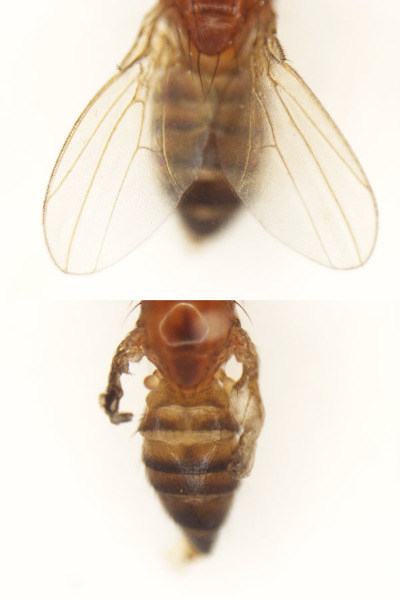May 8, 2023 Research Highlight Biology
Flies aren’t freaks when it comes to cell death
Despite what’s written in textbooks, fruit flies use a similar cell-stress sensor as mammals to initiate programmed cell death
RIKEN geneticists have uncovered a protein in fruit flies that many textbooks say doesn’t exist1. The protein detects stress in cells and sets them on a pathway to self-destruction when they are overly stressed.
Damaged cells in our bodies eliminate themselves by initiating a suicidal process of programmed cell death known as apoptosis. This process is essential for our health and for ensuring that cells don’t become cancerous.
The molecular cascade behind this process is highly complex, but it is triggered by a single protein that belongs to a family of proteins known as BH3-only proteins. These proteins sense stress in cells and are found in many animals including mammals and nematodes.
However, for the last two decades, fruit flies, and possibly all insects, were thought to lack BH3-only proteins. Instead, they were believed to rely on a different cell-death program.
But now, in a surprise discovery, Sa Kan Yoo of the RIKEN Center for Biosystems Dynamics Research and co-workers have found that fruit flies do indeed harbor a BH3-only protein. They named the gene that encodes for it sayonara after the Japanese word for ‘farewell’.
When the team caused the sayonara gene to be expressed in fruit-fly wings, they observed apoptosis occurring, resulting in withering of the wings (Fig. 1).

Figure 1: Expression of the sayonara gene in the wings of a fruit fly causes the wings to shrivel due to apoptosis. Reproduced from Ref. 1 and licensed under CC BY 4.0 © 2023 Y. Ikegawa et al.
According to Yoo, the gene was hidden in plain sight. “We didn’t do anything fancy,” he says. “We used the genetic sequence for a human BH3-only protein and checked whether the genome of fruit flies has a similar sequence—it’s a very common way to find genes in fruit flies that correspond to human ones.”
Yoo suspects that incomplete sequencing of the fruit fly’s genome may explain why researchers didn’t find the gene in fruit flies 20 years ago. “Genomic sequencing was incomplete back then, so probably scientists couldn’t find the gene and after a while they just gave up.”
The fruit fly’s lack of a BH3-only protein subsequently became enshrined in textbooks. But for Yoo it posed an interesting challenge. “I thought it might be fun to check it,” he says. “And after just a few hours, I found something that looked suspiciously like a BH3-only protein.”
The finding implies that fruit flies, and probably other insects, aren’t so different when it comes to apoptosis. “It means that fruit flies aren’t an exception or a bit weird,” says Yoo. “Rather we found they have a similar mechanism for regulating apoptosis as humans and nematodes.”
The team is now exploring exactly what happens after the BH3-only protein is activated. They are also investigating if other insects have BH3-only proteins.

Sa Kan Yoo (left) and Yuko Ikegawa © 2023 RIKEN
Related contents
Rate this article
Reference
- 1. Ikegawa, Y., Combet, C., Groussin, M., Navratil, V., Safar-Remali, S., Shiota, T., Aouacheria, A. & Yoo, S. K. Evidence for existence of an apoptosis-inducing BH3-only protein, sayonara, in Drosophila. The EMBO Journal e110454 (2023). doi: 10.15252/embj.2021110454
